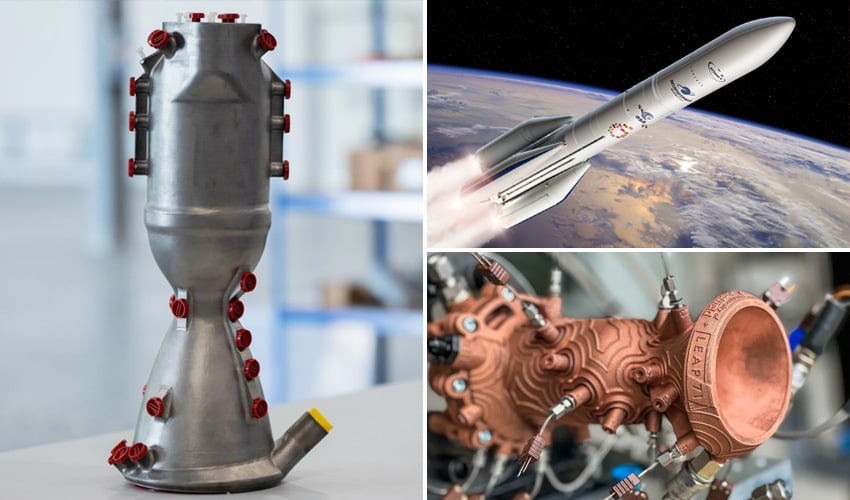Space Race 2.0: 3D Printing's Role in Rocket Revolution

Since the momentous moon landing in 1969, humanity's desire to explore the cosmos has only intensified. However, the methods of reaching the stars have dramatically evolved. The advent of additive manufacturing, commonly known as 3D printing, has ushered in a new era of innovation in rocket design. This article examines some of the most exciting projects pushing the boundaries of space travel, showcasing the transformative potential of 3D printed rockets and their components.
#
Agnibaan: India's 3D Printed Rocket Pioneer
Agnikul Cosmos, an Indian aerospace manufacturer, is leading the charge in making space accessible to all. Their 3D printed rocket, Agnibaan (meaning "arrow of fire" in Sanskrit), is claimed to be the world's first with a single-piece, 3D printed engine. While the specific technologies used remain undisclosed, the successful launch of Agnibaan on 30th May marked a significant milestone for the Indian space industry and demonstrated the viability of 3D printing in rocket development.
#
Launcher's E-2 Engine: Copper Alloy Revolution
Launcher, acquired by Vast in 2023, partnered with the US Space Force, Air Force, and NASA to develop cutting-edge rockets. Their E-2 liquid rocket engine is a testament to the power of 3D printing. This closed combustion engine features a copper-chromium-zirconium alloy combustion chamber, significantly reducing costs and reliance on traditional supply chains. Launcher is the first company to use 3D printed copper alloys for a rocket engine combustion chamber, highlighting the material's ability to withstand extreme temperatures and pressures. The E-2 engine's successful full-thrust test in April 2022 at NASA's Stennis Space Center further validated its capabilities.
#
Ariane 6: Europe's 3D Printed Heavy-Lifter
ArianeGroup, a joint venture between Airbus Group and Safran, developed Ariane 6, Europe's latest heavy-lift launcher. The maiden launch in July 2024 demonstrated the rocket's flexible design and ability to transport large payloads. 3D printing played a crucial role in Ariane 6's development, enabling cost reductions and shortened production cycles. Numerous engine components, including the combustion chamber, were additively manufactured, showcasing the technology's efficiency and versatility.
#
Skyroot Aerospace: 3D Printed Cryogenic Engines
Skyroot Aerospace, an Indian company founded in 2018, aims to democratise access to space through fast, precise, and affordable launchers. Their Vikram range of rockets features Dhawan engines, 3D printed cryogenic engines that operate using liquid natural gas and liquid oxygen, both requiring temperatures below -150°C. The use of metal additive manufacturing in the Dhawan-I and Dhawan-II engines, which have been successfully tested, demonstrates the technology's capability in managing cryogenic conditions, paving the way for more efficient and reliable space launches.
#
Ursa Major's Hadley Engine: Mach 5 Flight Success
Ursa Major, a US-based startup, is making waves in the aerospace industry with its partially 3D printed Hadley engine. The engine's successful flight test in March 2024, reaching Mach 5, showcased the technology's potential for high-performance applications. While specific details about the materials and processes used remain undisclosed, the Hadley engine's achievement underlines the role of 3D printing in creating powerful and efficient engines for the private space sector.
#
NASA's RDRE: A New Frontier in Propulsion
As a leader in space travel and flight science, NASA continues to push the boundaries of propulsion technology. The agency's development of a full-size Rotating Detonation Rocket Engine (RDRE) using 3D printing is a prime example. The RDRE utilizes a novel propulsion concept that harnesses supersonic combustion, enabling higher performance with lower fuel consumption. Manufactured using laser powder bed fusion and a NASA-developed GRCop-42 copper alloy, the engine is designed for extreme conditions and long-term operation. Successful tests in autumn 2023 demonstrated the RDRE's potential to support future lunar and Martian missions.
#
EOS and Hyperganic: Bio-Inspired Rocket Engine
In 2022, EOS and Hyperganic made headlines by using artificial intelligence (AI) and 3D printing to create an aerospike rocket engine with a complex design. Hyperganic's algorithmic design software allowed for the creation of a bio-inspired engine, showcasing the technology's ability to mimic nature's efficiency. The engine was initially printed from a nickel alloy using the EOS M 400-4 machine, and later scaled up for copper production. This innovative project demonstrates the synergistic potential of AI and 3D printing in designing and manufacturing advanced aerospace components.
#
LEAP 71: AI-Driven 3D Printed Rocket Engine
Dubai-based LEAP 71 has made significant progress in space technology using computational engineering and additive manufacturing. The company developed a rocket engine entirely digitally, without human intervention, using the AI-based software Noyron. This revolutionary approach streamlined the engine's design and production, reducing the entire process to just two weeks. The engine, 3D printed from copper using an EOS M290 machine, achieved a powerful 20,000 HP thrust, ideal for orbital rockets. LEAP 71's achievement exemplifies the potential of AI and 3D printing to accelerate space travel innovation.
#
Orbex Prime: Low-Carbon, Reusable Rocket
British aerospace company Orbex has developed Orbex Prime, a low-carbon, high-performance rocket built using Nikon SLM Solutions' SLM800 metal 3D printer. Powered by 100% renewable biopropane fuel, Prime significantly reduces CO2 emissions and incorporates a recovery system for reusability, promoting sustainable space exploration.
#
Relativity Space: Towards a Fully 3D Printed Rocket
Relativity Space has garnered considerable attention since its founding in 2015 for its commitment to creating a fully 3D printed rocket. The company's first rocket, Terran 1, was launched in March 2023, albeit without reaching orbit. The near-entirely 3D printed rocket, manufactured using DED and laser powder bed fusion, was the tallest 3D printed metal structure ever built. Relativity Space continues its journey with the Terran R, expected to be 90% 3D printed and capable of carrying 20 times more payload than Terran 1. Scheduled to launch from Cape Canaveral Space Force Base in 2026, the Terran R promises to be a game-changer in space exploration.
#
Latitude's Navier Engine: 3D Printing's French Innovation
Latitude, a French startup, specialises in designing micro-launchers. Their Zephyr model, equipped with the 3D printed Navier engine, exemplifies the technology's potential in the micro-launcher sector. The 30 kg engine, with a thrust of 1.2 tonnes, was manufactured from Inconel 718 using an SLM 500 machine in just a few days, showcasing the technology's efficiency and speed.
#
Rocket Lab's Rutherford Engine: 3D Printed for Success
Rocket Lab, a Californian private aviation company, developed the world's first battery-powered rocket, the Electron, which debuted in 2017. The rocket features the 3D printed Rutherford engine, whose components, including the thrust chamber, pumps, injector, and valves, were additively manufactured. Rocket Lab's commitment to 3D printing in developing the Rutherford engine reflects the technology's ability to reduce weight and production time, essential factors in the aerospace industry.
#
OPUS Aerospace: 3D Printed Combustion Chambers
French company OPUS Aerospace specialises in designing launchers and spacecraft. Their Mesange and Sterne launchers both feature the Torgos engine, whose combustion chamber was 3D printed in a single operation. The Mesange, scheduled for launch in 2024, will serve as a testbed for the Sterne launcher, showcasing the technology's potential for reliable and efficient rocket engine design.
#
Stoke Space: 3D Printed Reusability
Stoke Space, an American company, is developing the NOVA, a fully reusable rocket designed for daily flights into space. The company uses 3D printing to produce copper combustion chambers, which are quickly produced and can be reused due to their high conductivity. This innovative approach addresses the crucial need for reusability in space travel, reducing costs and environmental impact.
#
Conclusion: The Future of Space is 3D Printed
The examples outlined above highlight the transformative impact of 3D printing on the space industry. From fully 3D printed rockets to individual components, additive manufacturing is enabling faster production cycles, lower costs, and improved performance, all crucial factors for making space exploration more accessible and sustainable. As the technology continues to evolve, we can expect even more innovative and groundbreaking applications in the pursuit of humanity's relentless drive to conquer the cosmos.





